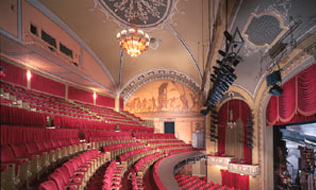












NOW PLAYING
COMPANY
Company, Stephen Sondheim and George Furth’s groundbreaking musical comedy, starring Tony and Grammy Award® winner Katrina Lenk and Two-time Tony Award and two-time Grammy Award winner Patti LuPone (in the role that won her the Olivier) returns to Broadway.
It’s Bobbie’s 35th birthday party, and all her friends keep asking why isn’t she married? Why can’t she find the right man? Isn’t it time she settle down and start a family? But Bobbie isn’t ready to commit. All her friends’ poking and prodding really could drive a person crazy!
The vision of two-time Tony Award-winning director Marianne Elliott (War Horse, The Curious Incident of the Dog in the Nighttime, Angels in America), this production of Company sheds revelatory light onto classic songs such as the acerbic “The Ladies Who Lunch” and the iconic “Being Alive.” Being married in 21st-Century New York has never been this fun. Let’s all drink to that!
Company Broadway Show Tickets | Company Broadway Schedule
HISTORY
The Bernard B. Jacobs Theatre (formerly the Royale) was originally built in 1927 by real-estate magnates, the Chanin Brothers, as part of a three-theatre complex that also included the Majestic (a large musical house) and the Theatre Masque, now the John Golden (a small house). The three theatres enabled producers to move shows based on their ticket sales to the most appropriately-sized venue. In 1930, the Chanins transferred ownership of all three houses to the Shuberts. During the Depression, control of the Jacobs passed to John Golden, who renamed the theatre after himself and ran it from 1934 to 1936. The Shuberts regained control in 1936, restored its name to Royale, and leased it to CBS as a radio studio until 1940. It was renamed the Bernard B. Jacobs in 2005 to honor the president of the Shubert Organization from 1972 - 1996.
ARCHITECTURE
Herbert J. Krapp designed the Jacobs and the other theatres in this complex under the unifying theme of “modern Spanish style.” The theatre's interior features a groin-vaulted ceiling supported on either side by archways decorated with two murals entitled "Lovers of Spain," by Willy Pogany.
Spotlight on Broadway: Bernard Jacobs Theatre from Spotlight on Broadway on Vimeo.
Details on the Bernard B Jacobs Theatre's Accessibility
Access Information
Theatre is not completely wheelchair accessible.
Shubert Audience Services
The Jacobs Theatre provides accommodations for patrons who are blind, deaf, partially sighted, and/or have hearing loss. The theatre provides infrared assistive listening devices for every performance at the theatre. In addition, beginning four weeks after a show’s official opening night performance, hand-held audio description devices and hand-held captioning devices are available, and there is unlimited access to downloadable audio description and/or captioning for personal mobile devices free of charge. (Hand-held devices are limited, although additional devices can be obtained with at least twenty-four hours’ notice.) If you have questions, contact Shubert Audience Services at 212-944-3700 or audienceservices@shubertorg.com. There is also a representative at the Shubert Audience Services kiosk at every performance to assist any patron with any of our devices, software, or technology.
Accessibility by Seating Section
Orchestra Location: Seating is accessible to all parts of the Orchestra without steps. There are no steps to the designated wheelchair seating location.
Mezzanine Location: Located on the Second Level, up 3 short flights of stairs (29 steps). Once on the Mezzanine Level there are approximately 2 steps up/down per row.
Handrails: Available at the end of every stepped seat row in the Mezzanine.
Wheelchair | Companion Seat Locations:
Orchestra: R102 | R101, P101-102; R113 | R114, P114-115; P3 | P1, O1-3; P7 | P9-13; I21 | I115-19; J24 | J18-22; R24 | R18-22
Aisle Seat with Folding Armrest | Companion Locations:
Orchestra: K1 | K3; N1 | N3; N2 | N4
Elevators/Escalator
None Available
Payphone
Located in the lobby. Accessible at 54".
Restroom
Wheelchair accessible (unisex) restroom located on the Orchesta level.
Water Fountain
Located in restrooms.
Theatre Policies
The use of cameras, recording devices, cell phones, beepers, and other electronic devices during the performance is prohibited. Everyone attending a performance must have a ticket. Latecomers will be seated at the discretion of management. Wheelchair and mobility-impaired seating is intended for patrons with mobility disabilities. Children under the age of four years will not be admitted. No outside food or beverage permitted, unless medically necessary. No weapons permitted on the premises.
THEATRE SPECS
Bernard B. Jacobs Theatre
242 West 45th Street
Between Broadway and 8th Avenue
New York NY 10036
| Year Built | 1927 |
| Seating Capacity | |
| Orchestra | 636 |
| Front Mezzanine | 168 |
| Rear Mezzanine | 252 |
| Boxes | 16 |
| Total | 1092 |
| Included in Numbers Above: | |
| Orchestra Pit | 30 |
| Wheelchair | 7 |
| Aisle Transfer Arm | 12 |
| Standing | 20 |
| Theatre Dimensions | |
| Proscenium Opening: | 40' 0" |
| Height of Proscenium: | 24' 0" |
| Depth to proscenium: | 26' 4" |
| Depth to front of stage: | 30' 1" |
| Stage Type: | Proscenium |


























